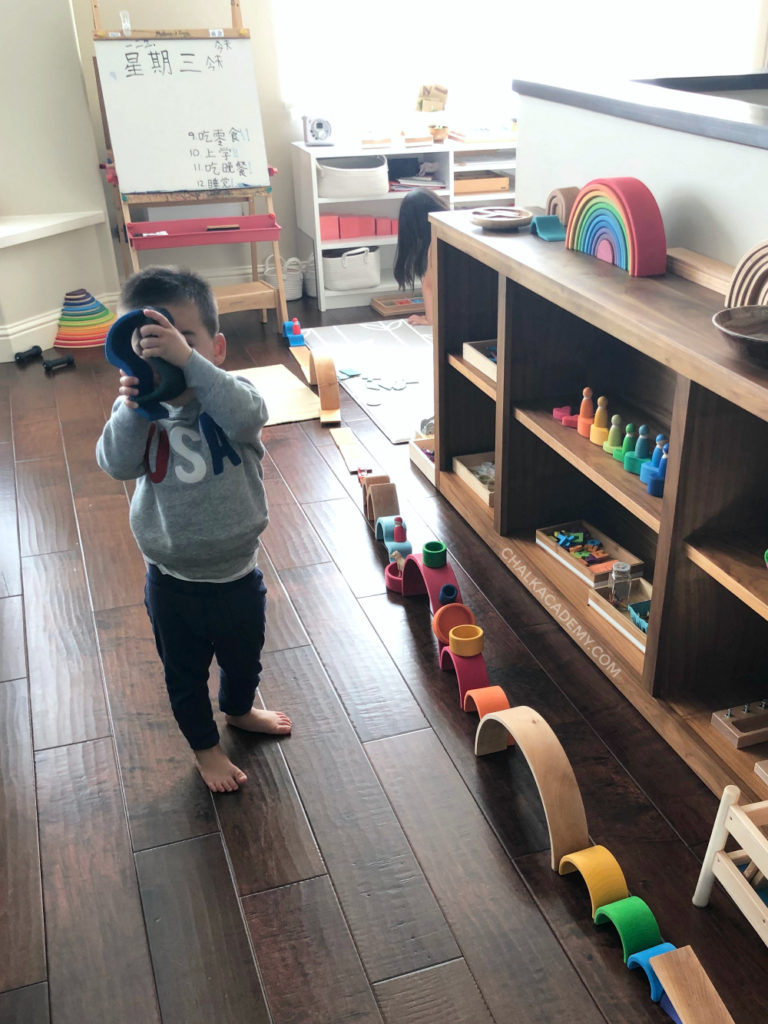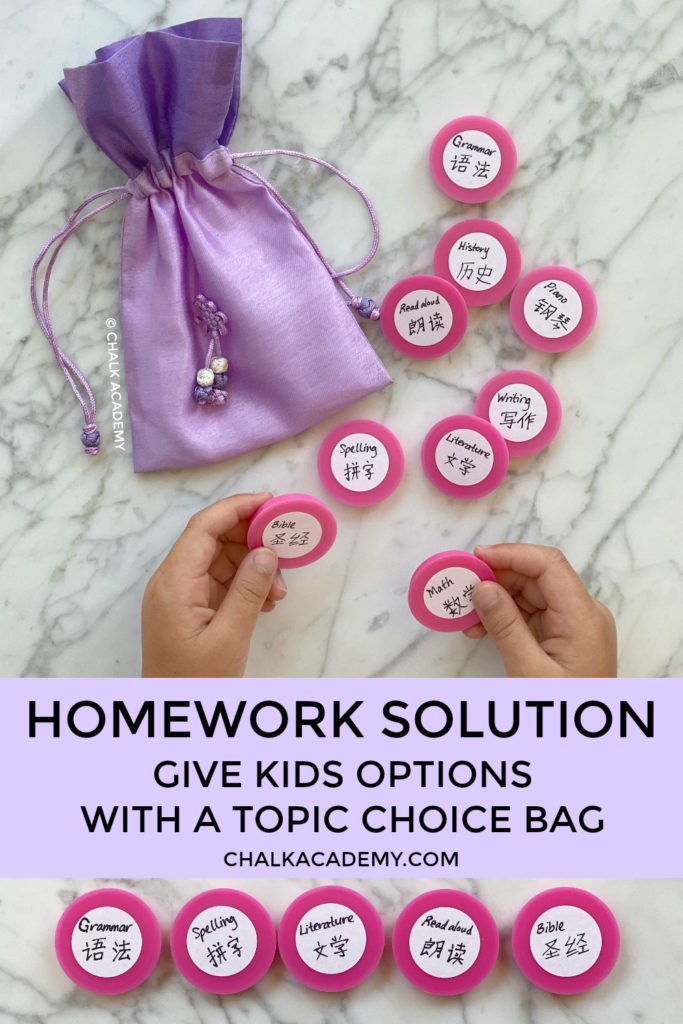Homework Routine: 5 Tips for Survival and Success
Hybrid homeschooling has kept us busier than ever this year! After about 2 months, we have achieved homework routine success…most of the time! Gone are the days where we had the luxury of Montessori-style homeschool preschool and even a bit of unschooling.
Now, almost 6-year-old 老大 (lǎodà / oldest child) attends elementary school part-time. We have to follow their first grade curriculum (second grade for math) while balancing my rambunctious 3-year-old 老二 (lǎo èr / second child) at home.
Chalk Academy is reader-supported. Some of the links are affiliate links. When you buy something through an affiliate link, we may earn a very small commission at no cost to you. Details here.
Figuring out a homework routine with 2 young children
Hybrid homeschooling basically involves me teaching my daughter for a few hours, 3 days per week. Therefore, what would have been classroom instruction has turned into family homework.
Typically, this involves workbooks and textbooks, but I try to supplement with DIY or traditional Montessori materials to keep the process interactive.
However, balancing the needs of my older and younger child has been the biggest challenge. Although 老大 can stay focused in one spot for several hour periods, 老二 is a sibling who needs constant movement!
Homework routine trial and error
On our first homeschool day, I thought it might be fun to do homework at our local barn.
We go there every few weeks anyway, and I imagined 老二 happily feeding goats while 老大 and I read history from Story of the World.
Well… I couldn’t have been more wrong! 老大 was suddenly hyperaware of various animal poop smells, and we had a tough time hearing each other through the'”咩 (miē)” and the “哞 (mōu)” of the goats and cows!
We’ve also tried the “work before play” strategy, and that caused even more misery.
I felt a lot of doubt and wondered “How can I help 老大 complete our assignments while our toddler desperately needs to play?”
Although I successfully taught 老大 the foundations of Chinese and math, how will we have time to cover other important subjects?
Creating a Homework Routine: 5 Tips for Survival and Even Success
Finally, after trial and error and lots of prayer, our homework routine is falling into place, and we have more peace!
My children are learning, and I am learning, too!
Our evolving homework routine has been helpful for teaching 老大 the importance of being organized yet flexible.
Together, we are working on time management and learning how to prioritize tasks.
Here are 6 key steps that we took to make homework routine manageable and productive.

1. Remove distractions
Sibling distractions
Teaching our children to respect each other’s personal space is an ongoing daily challenge. Like most toddlers, 3-year-old 老二 is still learning impulse control. He is physically incapable of being still and quiet!
If we are struggling to complete sit-down homework, we save it for when my husband is home and we can divide and conquer.
Since my husband works overtime during the week, we sometimes binge on homework during the weekend when we can provide one-on-one attention to each child.
However, this option is not available on most days, so keep reading to see what we normally do!
Environmental distractions
As much as we love siblings, we know they can be a potential distraction! Therefore, minimizing other background noise is especially important.
During reading time, we try to keep our CD player off during reading. With other work, such as spelling or copywork (handwriting), music can be played softly.
To avoid distractions from my phone, I turn the volume and notifications off. I try to resist the temptation to check emails and social media which make me feel FOMO when in reality, they are unimportant and steal attention away from family.
Other items like iPads, TVs, and noisy toys are obvious offenders to attention span that should be excluded from a learning space.
However, clutter can be an insidious distraction. Therefore, we periodically donate outgrown toys and recycle unnecessary papers which can make concentration challenging for other tasks.
As my kids’ creative messes grow with age, I involve them with the process of saying goodbye to things they no longer need.
Explore this: How We Transformed Our Play Area / Homeschool Room – Before and After Guide

2. Organize books and school supplies
Resources, such as books, pencils, and homework checklists should be easy to reach and find.
Infrequently used school supplies may need to be stored away to improve access to important materials.

For our family, the art cart has been extremely helpful for organizing and making commonly used supplies easy to find. We also organize homework by subject inside our “dining” cabinet.
3. Brainstorm the best time for homework
Since we home school part-time, our schedule varies from day-to-day. Extra curricular activities, such as swim, ballet, soccer, and piano, are sprinkled throughout the week.
Based on teacher availability, some of these lessons are in the morning while others are in the evening.
Therefore, every morning, we talk about the time of day that we plan to do homework. Then, my daughter writes out the plan on our easel.
On some days, my children need to get their energy out at the park before doing homework.

4. Create a homework checklist with freedom of choice
Since the homework routine is about the child and her homework, her opinion is incredibly important.
In fact, when 老大 was playing a mystery bag activity with 老二, she came up with a “homework choice bag” idea.
The bag contains recycled bottle caps with required topics written in both Chinese and English, the 2 languages my daughter and I use while doing homework.
How the “homework choice bag” works
- At the start of homework time, 老大 will choose set out the topic caps in the desired order.
- When she’s done with the subject, she puts it back in the bag.
Including cultural reminders with English homework
Although all of her homework is in English, the “homework bag” has a couple of multicultural elements:
- Bilingual Chinese/English text serves as a visual prompt to remember to speak one of the minority languages with mommy.
- Korean drawstring pouch gifted by her paternal grandmother (similar version here)

5. Have “Plan A” and “Plan B” homework study areas
“We cannot take the child’s attention and carry it where we will, but we should observe where the child’s attention tends to go, for that tendency reveals the path existing within the child or the developmental need that the child possesses by nature. And this fact is repeated, not only in the child, but, I believe, throughout the whole life of the individual.” – Dr. Maria Montessori
Ideally, a designated work area consists of a comfortable chair, child-sized desk, bright light, and a quiet room.
As my children grow older, the eventual plan is for each child to have this utopia of a learning setting!
In reality, life can be unpredictable with my 3-year-old toddler.
Expecting him to sit at a table is unfair to his developmental needs, so we have flexible homework areas for my 1st grader.
I call these “Plan A”, “Plan B”, and “Plan C” etc. homework areas.
If my son wants to zoom cars and build blocks, my daughter and I work on an adjustable lap tray (similar here) or Montessori work rug in the play area.
Working on the floor gives both of my children more freedom of movement while enabling them to concentrate on their desired tasks. (As a side note, most of our toys are open-ended to promote independent, creative play).
Sometimes, we spread out on the dining table. This allows us to be together while giving both children plenty of space to create!
For lengthy reading assignments, the 3 of us might snuggle and read on the couch.
However, if my son is particularly antsy and needs to get out and run, we take 老大’s backpack to the park.
Setting up a homework routine: lessons learned
Children are never static, and our homeschool routine will inevitably change as they mature.
So far, a flexible homework routine has worked best for my 1st grader while accommodating my toddler’s physical needs.
However, organization, freedom of choice, my children’s opinions, and removal of distractions will remain important factors, regardless of my children’s age.
Does your child have a homework routine?
What tips or challenges would you like to share with other families?
I’d love to hear about your family’s experience and brainstorm ideas with you!
Please leave a note in the comments!
More about our home learning journey
- Raising Multilingual Children as a Non-Fluent Parent is Possible
- Teach Your Child a Second Language at Home with 5 Key Steps
- How I’m Teaching My Children Basic Math For Free and Without Workbooks
Hi! Great tips and thank you for sharing. Your point 4, does your daughter do all the topics in one go.everynday or does she choose which one to do on the day?
Hi Sue! Thank you for reading and commenting! This is something we are figuring out still. When we follow the school’s assignment grid, we feel rushed jumping from topic to topic. Unfortunately, the school also discourages students from going more than 1 week ahead of the grid. So far, it seems to work best when we do fewer topics per day and combine Monday/Wednesday/Friday’s homework for that topic in one day. Then the next day, delve deeper into other topics. We use Montessori materials to supplement the school’s required textbooks/workbooks.